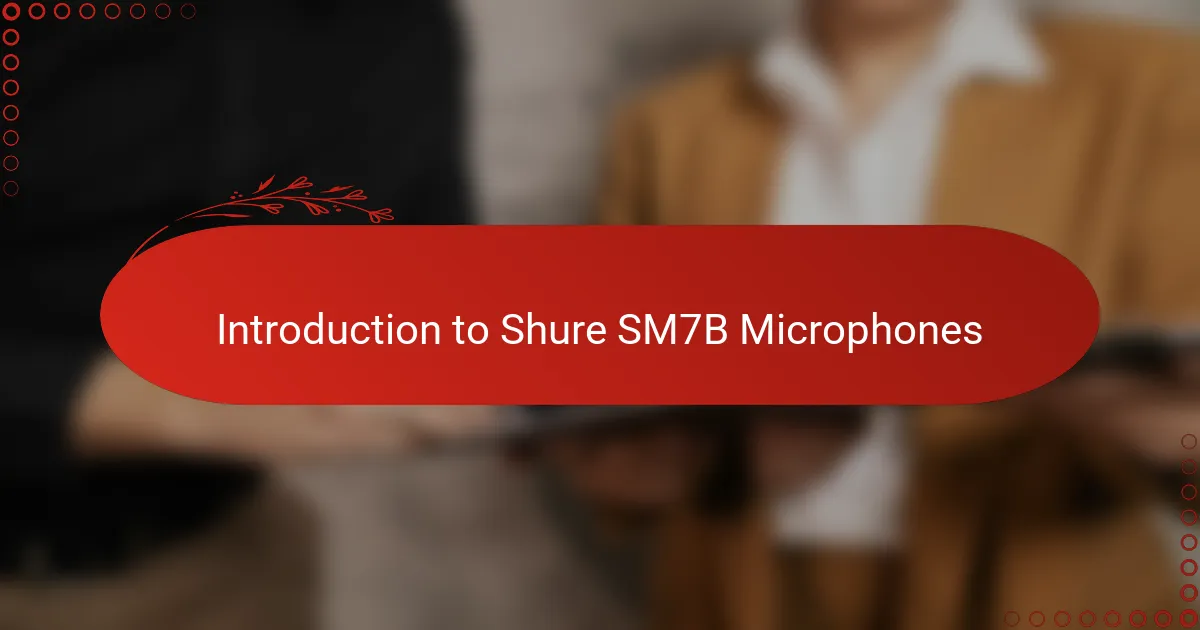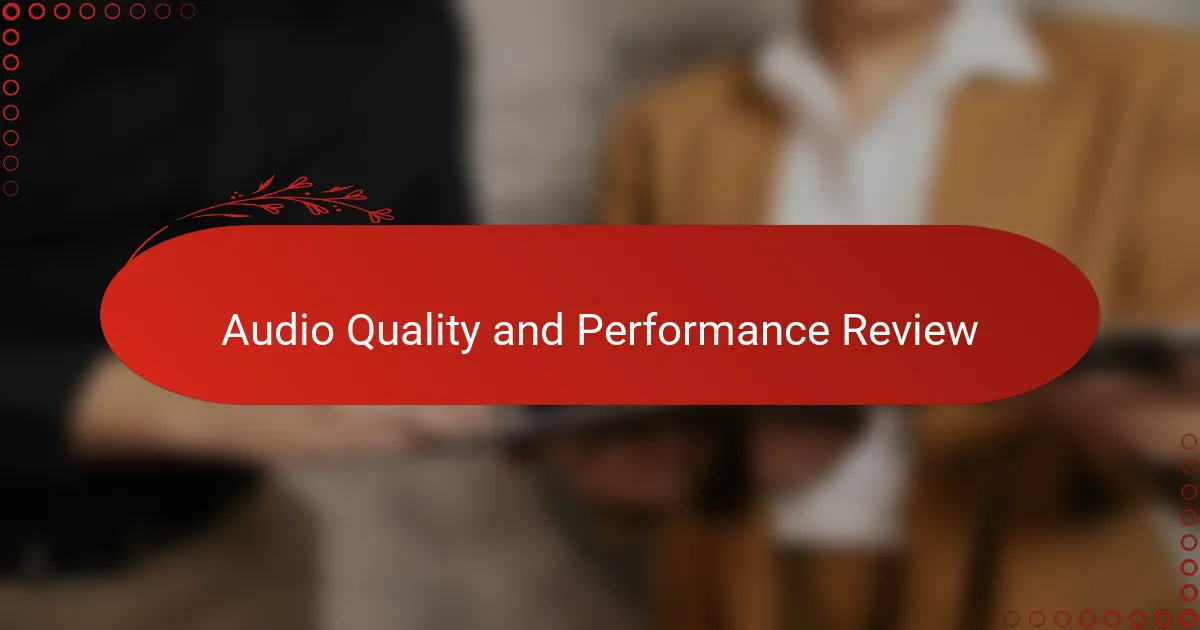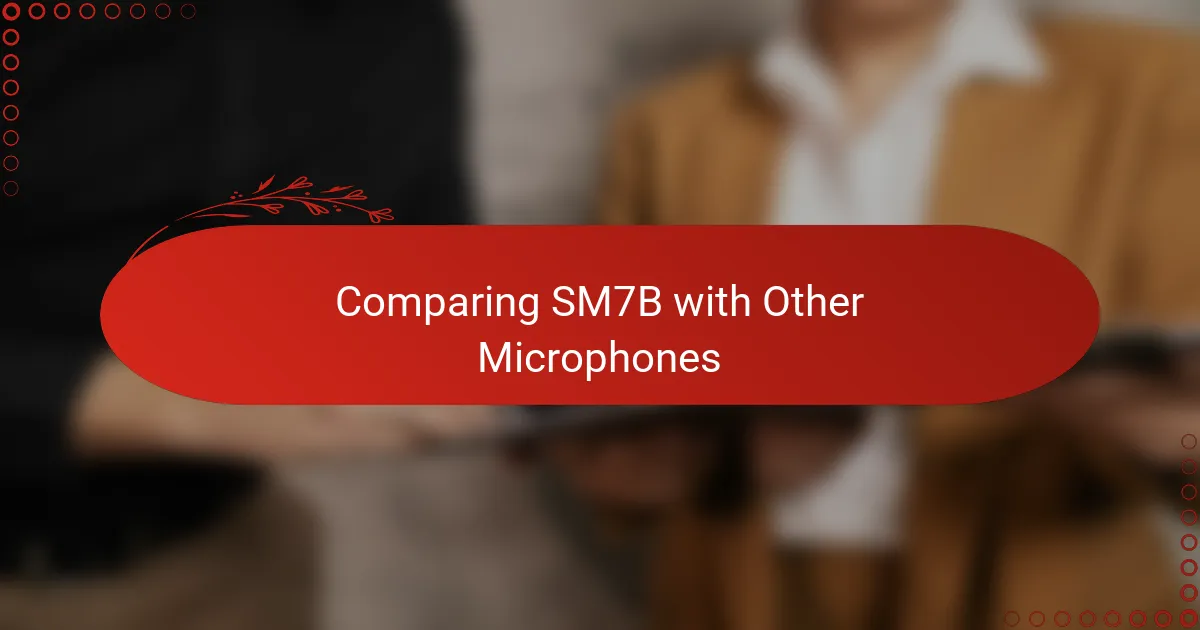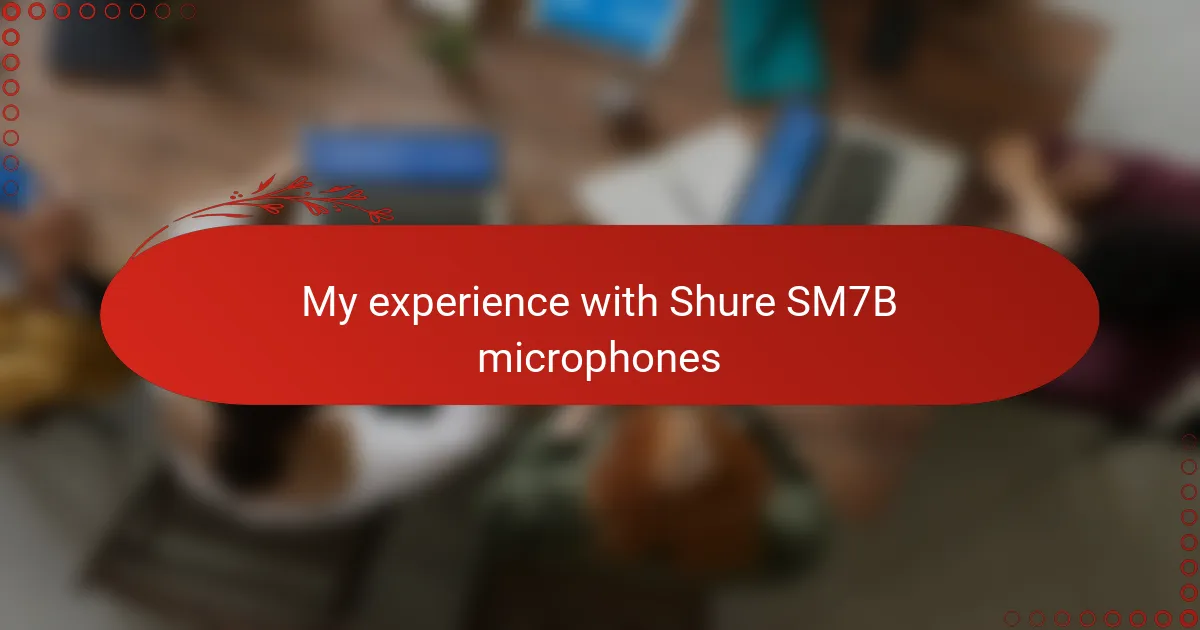Key takeaways
- The Shure SM7B microphone is renowned for its solid build, warm sound, and excellent background noise rejection, making it ideal for broadcasting and podcasting.
- Key features include a built-in pop filter, optimized frequency response for speech, and internal shock isolation, which enhance audio quality and clarity.
- Proper setup is crucial; using a good preamp with sufficient gain and positioning the mic correctly significantly improves sound performance.
- Finding the right gain and utilizing the mic’s built-in adjustments can further optimize recording quality, transforming the overall broadcasting experience.

Introduction to Shure SM7B Microphones
The Shure SM7B is widely known as a go-to microphone for radio broadcasters and podcasters alike. When I first picked it up, I immediately noticed its solid build and the smooth, warm sound it delivers. Have you ever struggled to find a mic that makes your voice sound natural yet polished? This one might just be the answer.
What makes the SM7B stand out is its ability to reject background noise and deliver a clean, professional tone. In my experience, this mic creates a near-studio quality sound even in less-than-ideal environments. It’s like having a secret weapon in your broadcasting toolkit that consistently elevates your audio game.
I remember the first time I used the Shure SM7B during a live radio session—its presence and clarity completely changed how listeners engaged with my voice. It sparked a confidence in me, knowing that the technical side of my broadcast was handled perfectly. Isn’t that the kind of reliability every broadcaster wants?

Shure SM7B Features for Broadcasting
One feature that truly impressed me about the Shure SM7B is its built-in pop filter. It effortlessly smooths out those harsh plosives without needing extra equipment, which made my broadcasting setup simpler and my voice clearer. Have you ever had to edit out distracting pops and hisses? This mic pretty much solves that problem right at the source.
Another standout aspect is the microphone’s frequency response tailored for speech. It accentuates the warmth and presence of the human voice, making every word sound natural and engaging. When I spoke into it during a remote broadcast, the difference was clear—the SM7B gave my voice a richness that standard mics just couldn’t match.
Plus, the internal air suspension shock isolation is a game changer. It significantly cuts down on unwanted mechanical noise, so bumps on the desk or handling sounds don’t ruin the broadcast. From my experience, this feature helped keep my recordings clean and professional, even when the studio environment wasn’t perfectly quiet. Wouldn’t you agree that’s a huge relief?

Setting Up SM7B for Radio Use
Setting up the SM7B for radio use took me a bit of trial and error at first. One thing I quickly learned is the importance of using a good preamp with plenty of clean gain—this mic needs it. Have you ever noticed how quiet the SM7B can sound without enough amplification? That was me fumbling around until I got the right combo.
Positioning the mic correctly also made a huge difference in my broadcasts. I found that keeping it about two to three inches from my mouth and angled slightly off-axis helped capture the warmth without picking up unwanted breath noises. Finding that sweet spot felt like tuning a fine instrument, and it definitely paid off in clarity.
Mounting the mic on a sturdy boom arm was another critical step. It not only freed up desk space but minimized handling noise, which the SM7B otherwise might pick up despite its shock isolation. I’d say investing in a solid arm is just as important as the mic itself—don’t you agree? It made my whole setup feel more professional and comfortable.

Audio Quality and Performance Review
When I first heard my voice through the Shure SM7B, I was genuinely impressed by the smoothness and depth it brought out. The midrange warmth really made my speech feel intimate and engaging, something I hadn’t experienced with other mics I’d tried. Have you ever felt your voice sounded flat on recordings? This mic solved that issue immediately for me.
What really stands out in performance is how the SM7B handles dynamics. Loud or soft, my voice stayed clear without distortion or harshness, which made live radio sessions feel more natural and less fatiguing. From my perspective, that reliability in sound consistency is a broadcaster’s dream come true.
The noise rejection is another highlight I can’t overlook. In a busy studio, with computers humming and footsteps nearby, the SM7B kept the background noise out of the mix without me needing to tweak settings constantly. It’s like having a strong filter working silently behind the scenes—how often do you get equipment that just quietly does its job so well?

Comparing SM7B with Other Microphones
When I first compared the SM7B to other popular broadcast microphones, its warmth and clarity immediately set it apart. Other mics I tried often sounded either too harsh or too dull, but the SM7B hit that perfect balance, making my voice feel alive without sounding artificial. Have you ever put on headphones and felt like your voice just didn’t come through right? That’s exactly what this mic fixed for me.
I also noticed how much better the SM7B handled background noise compared to dynamic or condenser microphones I’d experimented with. While some mics picked up every little click and hum, the SM7B seemed to create a quiet bubble around my voice. This made a huge difference during live broadcasts, where distractions can ruin the listener’s experience.
One thing to keep in mind, though—unlike some USB mics that work straight out of the box, the SM7B demands good amplification and a proper setup to shine. It’s less “plug and play” and more “invest and fine-tune.” But once you get it right, the audio quality you get is worth every bit of effort. Have you ever found a piece of gear that feels like it pays you back tenfold when you put in the work? This is that gear.

Tips for Optimizing SM7B Sound
One tip that really transformed my SM7B sound was dialing in the gain just right on my preamp. Too little gain, and the mic sounds lifeless; too much, and you start hearing unwanted hiss. Finding that balance took a few tries, but once I nailed it, my voice came alive with clarity and warmth—have you ever experienced that rewarding “click” when everything just sounds perfect?
Another trick I swear by is using the SM7B’s built-in bass roll-off and presence boost switches. Engaging these settings helped tame some of the boominess in my voice and added extra crispness where I wanted it. I used to shy away from any adjustments, thinking “flat is best,” but now I’m convinced that subtle tailoring makes a huge difference in professional-sounding broadcasts.
Finally, positioning remains key. I learned that angling the mic slightly off-center and maintaining a consistent two-inch distance from my mouth reduced breath noises without sacrificing intimacy. It felt like learning to speak into a finely tuned instrument—small shifts changed the entire vibe. Have you ever caught yourself leaning too close or too far and wondered why your recordings suddenly sounded muffled or harsh? That’s why mic placement is more than just a setup step; it’s part of the craft.

Personal Experience and Recommendations
Using the Shure SM7B in my daily broadcasts has been nothing short of transformative. I recall the first few sessions where I felt an immediate boost in confidence simply because the mic captured my voice so authentically—it’s like it understood exactly how to highlight my tone without any extra effort on my part. Have you ever had that moment when your gear just “gets” you? That’s the SM7B for me.
I also want to highlight how forgiving the SM7B is once you get past the initial setup hurdles. Yes, it demands some patience and the right preamp, but once dialed in, it feels like the mic becomes an extension of your voice, consistently delivering broadcast-ready audio. For anyone serious about radio, I’d say investing time into mastering this mic pays off in spades.
If I had one recommendation, it’s to respect the learning curve and not rush the setup process. Experimenting with positioning and gain, as I did, revealed subtle nuances that made a huge difference to my on-air sound. Trust me, those small adjustments turn a good mic into your signature broadcast voice—don’t you want your listeners to hear you at your absolute best?
